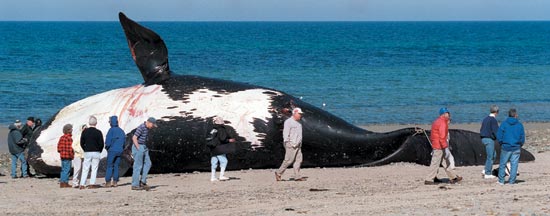The first of the monster offshore wind arrays is ready to roll, with construction to begin in May. The acoustic hammering on the whales and other sea critters will now escalate from sonar survey blasting to the incredible noise of pile driving. Each huge wind tower sets on an enormous monopile that has to be driven into the sea floor.
The project bears the happy name Vineyard Wind but there is no vineyard. Here is how they put it: “Vineyard Wind is currently building the nation’s first utility-scale offshore wind energy project over 15 miles off the coast of Massachusetts.” There are 62 enormous wind towers, each among the world’s biggest at 13 MW. See https://www.vineyardwind.com
For the incredible threat of pile driving noise see my https://www.cfact.org/2022/07/26/threat-to-endangered-whales-gets-louder/ Pile-driving noise can deafen, injure or even kill marine mammals. See for example https://www.arcticwwf.org/the-circle/stories/regulating-underwater-noise-during-pile-driving/ for a good discussion of the threat.
ndApparently this does not matter because Vineyard is federally authorized to injure hundreds of whales and thousands of other marine mammals, especially dolphins.
See Table 1 at https://www.fisheries.noaa.gov/action/incidental-take-authorization-vineyard-wind-1-llc-construction-vineyard-wind-offshore-wind for species specific take authorizations.
Here are the horrendous injury authorization numbers by group:
145 whales including 66 humpbacks and 20 right whales
6,040 dolphins
154 porpoises
851 seals
Of course these hellish damage limits are unenforceable, because the injuries occur out of sight underwater, but they show just how great the threat is. In fact they are merely estimates of the potential adverse effects.
The authorization numbers are derived basically as follows. First there is what is deemed a safe sound level. Using a sound propagation model they then estimate the area around the pile driving where the sound exceeds this safe level. They then use a species population density model over time to estimate the number of critters that will be exposed to unsafe sound. This number is used to derive an authorization number.
These are very crude estimates so the adverse impact numbers could easily be much greater. Population densities at a given place can vary greatly over time, for example.
From an engineering point of view the monopiles are amazing. Each is over 30 feet in diameter and several hundred feet long. They are driven so far and firmly into the sea floor that they hold a turbine-and-blades mounted tower hundreds of feet tall steady in major hurricane force winds (or that is the hope).
The pile driving forces have to be tremendous to get the piles that well imbedded, which is why there has to be so much impact noise. In this case the 13 MW turbines are much bigger than anything found in today’s big arrays around the world, where the biggest is just 9.5 MW. The forces involved should be at least that much bigger, so the driving noise might also be underestimated in the authorization numbers.
The potential damage to whales and other marine mammals is clearly huge, based on the official NOAA Fisheries impact authorization estimates. It is hard to see how this hell can be allowed under present laws, such as the Marine Mammal Protection Act and the Endangered Species Act.
Ironically the Vineyard Wind home page features a short video showing two whales swimming away. That come May these might be whales fleeing desperately, because they have been deafened by excruciating pile driving impact noise, seems not to have occurred to them.
David Wojick, Ph.D. (dwojick@craigellachie.us) is an independent analyst working at the intersection of science, technology and policy.
This article originally appeared at CFACT.org, and is republished with permission.
For more on offshore wind and right whale deaths, click here.


























